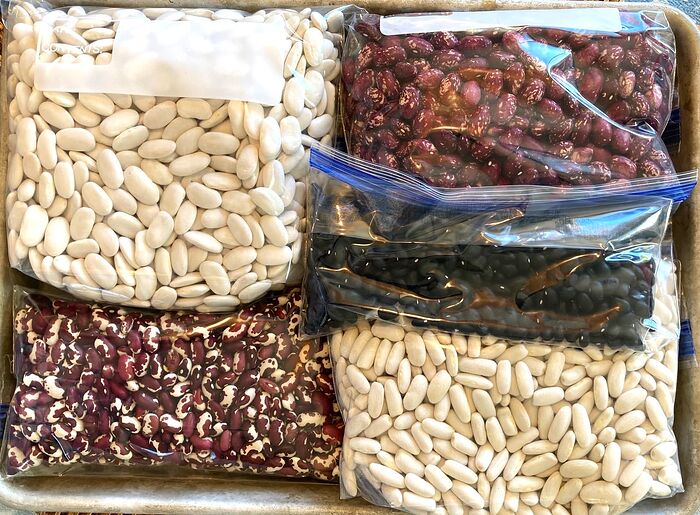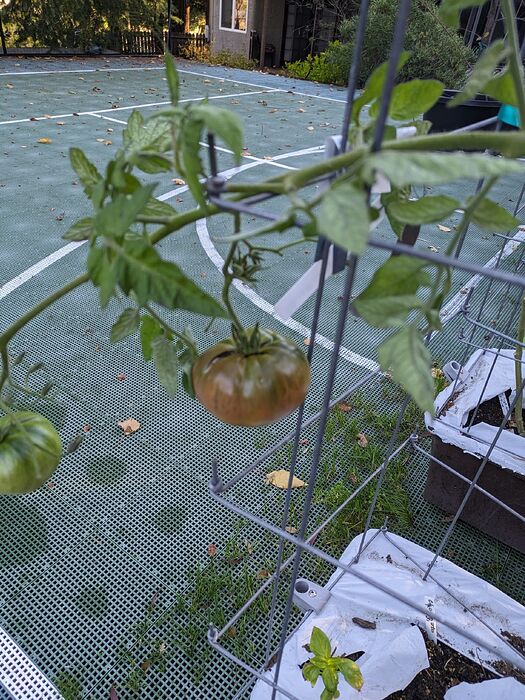I hope they are making those things better than they used to. We bought one when they first came out. After several weeks the pump gave out. They sent us a replacement, but our tomato starts died before it came. We tried again, and the pump gave out again. At that juncture, we gave up. This was maybe a decade ago?
I have three now, the oldest purchased in 2016, motor still works, although I don’t use that one much. I have two newer ones, with led lights and seed starting inserts, and that’s mostly, what i use them for.
Bean shelling day.
Starting in the upper left corner and going clockwise: tarbais, cranberry, turtle, canellini, jacobs cattle.
I’m about ready to give up on the turtle and jacobs cattle. I never seem to get much return for the effort on the cattle beans, and the turtle beans are always pretty small. On the flip side, the tarbais did really well this year, so “yay” for that.
Popping these in the freezer for a week to make sure there are no stow-aways (alternatively, 30 minutes in a 160 degree oven should give same results).
Beautiful! Can you help me understand the yeild vs space for dried beans? Like how many square foot per bean eater?
I just cooked some dried Mayacoba (Peruano or Canary) beans for white chicken chili.
Pretty beans! I always worry about using heat, fearing case-hardening them. I use the freeze method. Then, they go in glass jars, bottles, in a cold basement.
I’ve wondered if dried beans, stored with oxygen absorbers, would remain fresh longer. On one hand, no oxygen to cause rancidity; on the other hand, the live seed would die faster. With wheat, ground grains and corn, the oxygen absorbers work great, and kills any insects or eggs.
Want to go bean crazy? Check out Russ Crow’s bean collection! I’ve received some of his seeds. Too many beautiful types.
Not sure what MunchkinRedux’s experiences have been, but here, bean yields are variable, depending on the variety. Pole beans yield more per square foot, but you need a trellis, teepee, etc. Per square foot, there isn’t much yield with bush beans, 1/4–1/2 cup maybe? I’m always surprised at the (low) yield in a 40 foot row of bush types.
What bogman said!
Actually, I’m still in the Luck of the Draw phase as far as yield goes. Sometimes I’ll get a great return out of a small space, and other times, not so much from the same variety.
For the last few years the cranberry beans (bush) and tarbais beans (require trellis) have done the best - more beans and bigger beans. I’ll try to remember to weigh these bags when they come out of the freezer, and give you an idea of the size of container we grew them in.
As Bogman described above, after freezing these will go into Mason jars and into a dark corner of the garage.
Bravo!!!
What’s the heat like on those? I’ve had poblanos ranging from no heat to pretty bloody hot, there doesn’t seem to be a standard. The ones I just picked were a little short of the average jalapeno.
I have bought and grown seeds of several cultivars looking for the zestiest, which are still only mildly spicy, and described as “medium” in seed catalogs. These work for me;
“Baron”, which replaced Tiburon at Johnny’s Seeds, and grows flat making them easier to roast and peel.
“Tiburon”
“Ancho 211”
"Ancho San Luis ".
They still vary, and I don’t know why.
Cool weather update.
Hitchin’ a ride! In the garage. Look at the size of her!
Working goats! Dixon, CA
Love your little greeny!
Nice greens! Whose motorcycle?
Thank you.
Was husband’s; now son’s.
I heard a horned owl last night!
Long live Scotch Bonnet Jean!
Last of the tomatoes
Expected to drop to 32 tonight! Still hope to start sugar snaps and sweet peas,andsow favas.


While the vegetable garden was minimal, due to drought, plants that don’t make seeds had to be planted to keep the varieties going, tubers and corms. Some large potted Galangal, Thai Ginger (Alpinia galanga) produced a good haul of tubers.
Aside from use in cooking, A. galanga has been shown to improve mental alertness..
The Chinese water chestnut harvest was good, but smaller than usual because they had to share the same pool with Chi Gu (Sagittaria trifolia var. edulis).
Freshly-dug Water Chestnuts:
Chi Gu:
It’s cold, muddy work getting these harvested from the muck they grow in. To avoid damaging/ruining lots of corms, they’re dug and found by hand. Now, they’ll get stored in a fridge dedicated to dormant roots, corms, tubers, etc.
That’s an interesting harvest? How long have you been growing those? What made you decide to grow them?
I’ve been growing these for about 20 years, in shallow pools dug into the garden’s hillside. Scrap/trimmings from greenhouse plastic is used for a liner.
The first time I bought fresh Water Chestnuts and cooked them, I was hooked! They are so much better than canned, milkier, sweeter, with a great crunch. Peeling them is tedious. but, some Chinese friends said that they don’t peel them. Maybe I’ll try that with some smaller ones.
The Sagittaria was a result of curiosity, the kind that overtakes the mind of a hopeless plant geek. I saw the corms for sale in the local Asian market and got some to try out. I had no idea what they were. The flavor of the cooked corms was a bit like crossing corn and potato. The flavor reminded me of the wild, native Arrowhead corms. Still a mystery plant, I planted some in wet soil, wondering if they were a kind of Arrowhead.
As a teenager, I collected all sorts of wild foods, including the native Sagittaria/Arrowhead corms. Those were MUCH smaller. When the large Chinese ones sprouted leaves, it was obvious what they were. Here’s a shot of an older pool, some years back:
Since then, I’ve learned that abundant organic fertilizer, added to the water every month, increases the yields of these semi-aquatic vegetables a lot.
It would be unethical to plant these where they could escape into local waterways and marshes, just in case they could be invasive. So, they’re grown on a dry hillside, far away from any watery habitat. Both plants have never set seeds.
Aside from providing tasty tubers, these plants can also be useful for cleaning water high in nutrients. They’re good at absorbing Nitrogen, Phosphorous and other would-be pollutants out of water. When I add fertilizer, a temporary algae bloom clouds the water. Within a week, the algae is gone and the water is clear again.
The local Grey Tree frogs breed by the hundreds in the pools, emerging as tiny, metallic green froglets. The pools act as Tiger Mosquito death traps. If the insects get past the frogs, the water kills any larvae that hatch; the water gets treated with Bacillus thuringiensis var. israelensis (Bti), a bacteria which specifically kills mosquito, black fly and fungus gnat larvae.



















